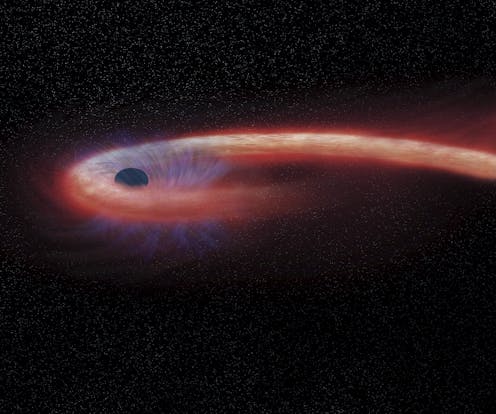Why are some black holes bigger than others? An astronomer explains how these celestial vacuums grow
- Written by Jaclyn Champagne, JASPER Postdoctoral Researcher, University of Arizona

Outlines around black holes
One of the most famous “white outlines” is the image of a black hole[16] from the movie “Interstellar[17].” In that movie, they were trying to show the white-hot, glowing ring of gases that are falling into the actively growing black hole.
In real life, we don’t get such a close-up view. The best image of the ring around a real black hole comes from the Event Horizon Telescope[18], showing scientists the supermassive black hole at the center of a galaxy called M87[19]. It might look blurry to you, but this doughnut is actually the sharpest image ever taken of something so far away.
There are lots of types of black holes out there in the universe. Some are small and invisible, and some grow to gigantic proportions by eating up stuff inside a galaxy and shining bright. But don’t worry, black holes can’t just keep sucking in everything in the universe – eventually there is nothing close enough to the black hole to fall in, and it will become invisible again. So you are safe to keep asking questions about black holes.
Hello, curious kids! Do you have a question you’d like an expert to answer? Ask an adult to send your question to CuriousKidsUS@theconversation.com[21]. Please tell us your name, age and the city where you live.
And since curiosity has no age limit – adults, let us know what you’re wondering, too. We won’t be able to answer every question, but we will do our best.
References
- ^ Curious Kids (theconversation.com)
- ^ curiouskidsus@theconversation.com (theconversation.com)
- ^ Black holes (theconversation.com)
- ^ “supermassive” black holes (theconversation.com)
- ^ astronomer (jackiechampagne.com)
- ^ Albert Einstein (www.britannica.com)
- ^ Karl Schwarzchild (www.britannica.com)
- ^ idea of a black hole (www.astronomy.com)
- ^ collapses under its own weight (universe.nasa.gov)
- ^ stellar mass black hole (www.nasa.gov)
- ^ many stars colliding and collapsing at once (science.nasa.gov)
- ^ stars can still orbit around them (theconversation.com)
- ^ must be a massive black hole (theconversation.com)
- ^ glowing ring (universe.nasa.gov)
- ^ DNEG/Warner Bros. Entertainment Inc./CQG 32 065001 (cerncourier.com)
- ^ image of a black hole (cerncourier.com)
- ^ the movie “Interstellar (www.imdb.com)
- ^ Event Horizon Telescope (eventhorizontelescope.org)
- ^ galaxy called M87 (science.nasa.gov)
- ^ Event Horizon Telescope (eventhorizontelescope.org)
- ^ CuriousKidsUS@theconversation.com (theconversation.com)
Authors: Jaclyn Champagne, JASPER Postdoctoral Researcher, University of Arizona

